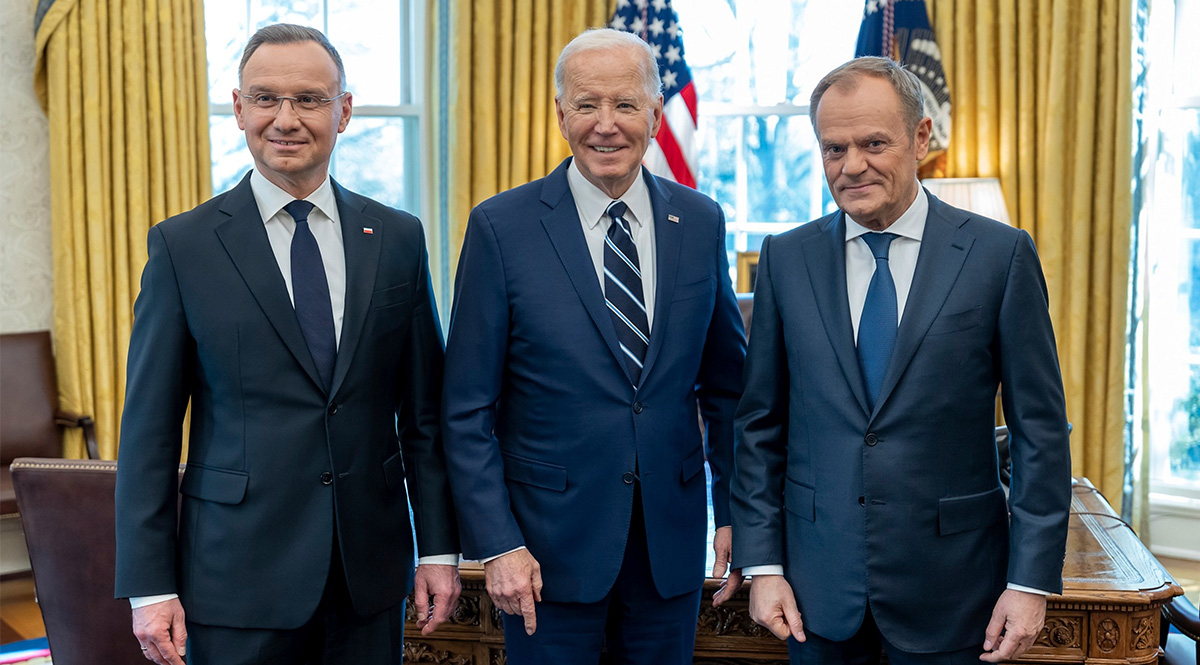Duda, Tusk Meet with Biden at the White House
On 12 March, President Andrzej Duda and Prime Minister Donald Tusk met with President Joe Biden. The visit was symbolic, timed for the 25th anniversary of Poland’s membership in NATO. The visit included substantive talks on bilateral defence and energy cooperation, cooperation within the Alliance, and support for Ukraine. Concurrent with the visit of the Polish delegation, the U.S. administration declared the possibility of further deliveries of armaments helpful in the further modernisation and expansion of the Polish armed forces.
 Adam Schultz/White House / Zuma Press / Forum
Adam Schultz/White House / Zuma Press / Forum
What were the political goals of the meeting for each side?
The unusual format of the talks—a simultaneous visit by the Polish president and prime minister—was aimed at the U.S. obtaining assurances from the new Polish government for the continuation of key directions of bilateral cooperation, including major arms programmes and the construction of a nuclear power plant. At the same time, the Biden administration was keen to obtain confirmation of cross-party consensus in Poland on foreign and security policy issues, especially on cooperation with the U.S., strengthening NATO, deterring Russia, and support for Ukraine. For Poland, the visit was an opportunity to emphasise its strategic role as a U.S. ally on NATO’s Eastern Flank. It also sought to reaffirm U.S. security guarantees under Article 5 of the Washington Treaty in order to reduce public concern over the Russian threat. The joint meeting with Biden confirmed the crucial importance of relations with the U.S., regardless of the political composition in Poland.
How can Poland’s leadership message influence U.S. policy?
On the occasion of the visit, President Duda called for raising the defence spending threshold of NATO countries to a minimum of 3% of GDP, announcing attempts to persuade allies to make such a commitment. Starting such a debate on raising the spending threshold among allies could put pressure on countries spending less on defence than the 2% agreed in 2014. The president also met with representatives of both parties in Congress on maintaining support for Ukraine. On this issue, he spoke with Speaker of the House Mike Johnson, a key figure in getting Biden's aid package passed by the House of Representatives, where Republicans hold the majority. Movement of the package through the U.S. Congress appears minimal, however. It has become a strongly domestic issue, polarising the electorates of the two parties, and adoption of the package is further hampered by the quickly intensifying campaigns ahead of November’s presidential and congressional elections. Nonetheless, the signal from Poland is important in terms of continued funding support for Ukraine, and success of the overall effort by the administration, Democrats, and U.S. allies cannot be ruled out.
What weapons systems is the U.S. ready to deliver to Poland?
During the talks, the U.S. administration proposed to the Polish delegation a $2 billion loan for the purchase of AH-64 Apache helicopters, while the State Department agreed to supply additional missiles to the Polish Air Force. The purchase of 96 AH-64 attack helicopters would enhance Poland’s ability to combat ground targets, including armoured forces and ground targets of a potential aggressor. In turn, deliveries of AIM-9X Sidewinder (232) and AIM-120C-8 AMRAAM (745) air-to-air missiles worth a total of $1.9 billion, would increase its ability to eliminate aircraft and cruise missiles. However, the most serious security implications for Poland and NATO would be the full delivery of as many as 821 AGM-158B-2 JASSM-ER advanced cruise missiles with a range of 900-1,000 km (cost with logistics of $1.77 billion). Poland already has an undisclosed number of the JASSM-ERs, as well as the older JASSMs with a range of 340 km. A multiplication of Poland’s offensive arsenal—the State Department's approval does not specify possible delivery schedules for JASSMs—would significantly affect its deterrence and complicate all military plans of Russia and Belarus.





